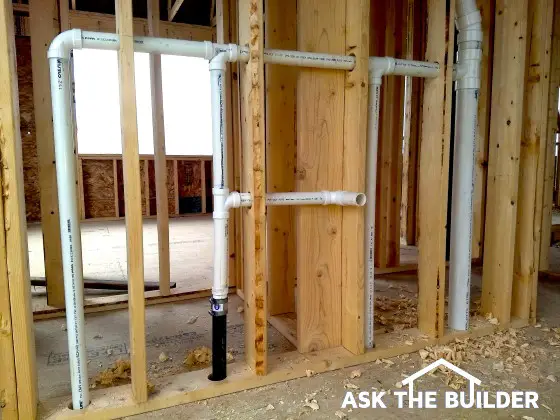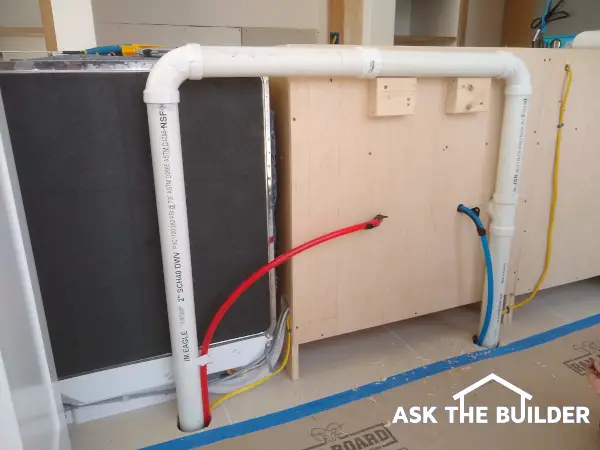How Do Plumbing Vents Work? – Air, Baby, Air!

How Do Plumbing Vents Work | Most of the pipes you see in this photo are vent pipes and wastewater never travels through them. You have almost as much vent pipe in walls and ceilings as you do drain pipes! Copyright 2021 Tim Carter
How Do Plumbing Vents Work? - They Let Air In
QUESTION: Hey Tim, I had the opportunity to tour a house under construction. All of the plumbing drain lines were in, but I also saw all sorts of other extra pipes that connected to the drain pipes and eventually combined and went up through the roof.
It got me thinking, “What are these pipes and why were they installed?” What’s more, do you think I have these same pipes in my home? It seems like a lot of wasted pipe to me. Sharon A., Lake Wales, FL
You may not have ever been blessed to see what Sharon did. I say this because it can really be eye-opening to see the bones, wires, pipes, etc. in a home before the skin of drywall or plaster is applied. You’d be stunned to discover what’s just on the other side of that smooth coating if you had x-ray vision like Superman.
CLICK or TAP HERE to get FREE BIDS from local plumbers who can do a vent pipe.
I’ve been a master plumber since age 29. When I first jumped into the building business after getting my geology degree in college, I gravitated to carpentry, plumbing, electric, and roofing. All of those things were of great interest, but plumbing cast a long-lasting spell on me. I really enjoyed the challenge of the three-dimensional problem-solving you have to do to run all the drain and vent pipes in a typical home.
CLICK or TAP HERE and I will DRAW YOUR PLUMBING VENT PIPE diagram.
I wondered how it all worked and was lucky enough to work in many old homes where I saw how long-gone master plumbers of old installed giant cast-iron pipes. You often could still smell the oakum oil-soaked hemp used to pack the joints before they poured the molten lead to make the joints water-tight.
Indoor Plumbing Only Since the 1880s
It’s easy to fall into the trap thinking that indoor plumbing has been around for centuries. The truth is indoor plumbing is one of the newer innovations in building. It wasn’t until the late 1800s that people made the connection between common diseases and the lack of sanitary conditions in crowded cities. Once this happened, plumbers gained the stature of doctors because they, the plumbers, could keep you healthy by installing piping in such a way as to remove harmful waste from your home.
It didn’t take long for plumbers to figure out something you might have not paid much attention to back in high school physics class. I’m talking about the Venturi effect. When water rushes down a pipe and it passes an empty pipe, the moving water can create a vacuum.
Venturi Effect Sucks Water From Traps
If you don’t install vent pipes at each fixture in a plumbing system, the Venturi effect comes into play. Bad things can happen when you flush toilets, drain a tub, do laundry, etc. The water rushing and cascading through the pipes can suck the water out of the u-shaped traps under your sinks, tubs, floor drains, and showers. When this happens, vermin can crawl into your home, and sewer gas can enter as well.
The plumbers of old quickly discovered a plumbing system needs to breathe in air just like you breathe air into your lungs. You can demonstrate this quickly with a disposable simple plastic water bottle. Fill one of these cheap bottles with water and turn it upside down. The water will glug glug glug out of the bottle. There’s a battle going on between the water and the air outside the bottle. Air is struggling to get into the bottle to replace the water that’s emptied out.
Simple Water Bottle Test
Now do the same thing, but poke a very small hole or cut a thin slit in the bottom of the bottle and turn it upside down. The water drains from the bottle freely because air can enter the bottle through the small vent hole or slit you created in the bottle.
Roof Vent Pipe = Vent Hole in Water Jug
That vent pipe you see on your roof does the same thing as that tiny hole or slit you cut into the water bottle. It’s where the air is sucked down into the plumbing system each time you drain water from a fixture. You can connect all the vent pipes that connect to each plumbing fixture in your home to one simple pipe that exits the roof, or you can have several vent pipes pop through the roof to minimize the amount of pipe you use.

Kitchen Island Loop Vent Sink Plumbing | Eighty percent of the pipe you see in this photo is VENT PIPE! The only part that is drain pipe is that part next to the blue PEX water line. These are the pipes you may not see in a kitchen island that help prevent sewer gas from polluting your kitchen. Copyright 2021 Tim Carter
What Size Should Vent Pipes Be?
Plumbing vent pipes have to be sized correctly, they need to have a slope to them to drain any condensate back to the drain pipes, and they must be installed with great care. Plumbing codes address all of this and you always want to make sure vent pipes are installed with the same skill as drain pipes.
Are AAVs a Good Idea?
While on the topic, I’m not a fan at all of the modern air-admittance valves (AAV) that seem to be the belle of the ball. They have moving parts and we all know that things with moving parts fail sooner or later. Traditional vent pipe systems have no moving parts. Period.
I’ve recorded a great video for you that shows all the vent pipes in a new home. I think you’ll be amazed at how many there are and how they all connect to just one pipe that exits the roof in this very large home.
Column 1396
5 Responses to How Do Plumbing Vents Work? – Air, Baby, Air!